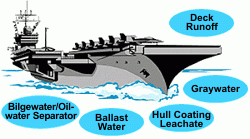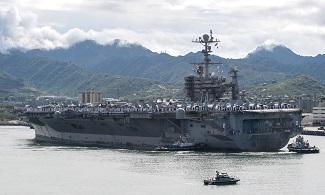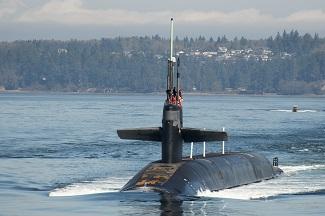Uniform National Discharge Standards (UNDS): Rulemaking Process
In 1996, Congress passed legislation amending the Clean Water Act to control discharges that are incidental to the normal operation of vessels of the Armed Forces. The legislation tasked the EPA and the Department of Defense (DOD) to establish national standards. The EPA and the DOD have agreed to establish performance standards in batches. This is referred to as batch rulemaking.
- How are the EPA and the Department of Defense (DOD) identifying and evaluating discharges?
- What discharges require marine pollution control devices (MPCDs)?
How are the EPA and the Department of Defense (DOD) identifying and evaluating discharges?
| Phase | Description | Rule Type | Status |
|---|---|---|---|
| Phase I | Identify and Characterize Discharges |
Joint EPA/DOD Rule |
Final Rule Published on May 10, 1999 |
| Phase II | Establish MPCD Performance Standards |
Joint EPA/DOD Rule |
Batch One Final Rule Published on January 11, 2017 Batch Two Rulemaking is Underway |
| Phase III | Develop Implementing Instructions |
DOD Only Rule | Must be Completed One Year After Phase II |
Phase I

On May 10, 1999, the EPA and the DOD published the Phase I final rule in the Federal Register (64 FR 25126 (PDF)(13 pp, 216 K); 40 CFR Part 1700 (PDF)(7 pp, 196 K, About PDF)). The Phase I rule identified all discharges incidental to the normal operation of vessels of the Armed Forces, and characterized each discharge to determine if it required control. The determination was made based on the potential of the discharge to have an environmental impact. The rule determined the types of vessel discharges that require control by a marine pollution control device (MPCD) and those that do not require control. The EPA and the DOD identified 39 discharges, 25 of which would require control by an MPCD.
The rule also established the mechanism by which states can petition the EPA to review whether or not a discharge should require control, and the processes the EPA and the states must follow to establish no-discharge zones.
What discharges require Marine Pollution Control Devices (MPCDs)?
Discharges Requiring Control
Click here for a list of definitions for these 25 discharges.
Phase II: Batch One
- Aqueous film-forming foam
- Chain locker effluent
- Distillation and reverse osmosis brine
- Elevator pit effluent
- Gas turbine water wash
- Non-oily machinery wastewater
- Photographic laboratory drains
- Seawater cooling overboard discharge
- Seawater piping biofouling prevention
- Small boat engine wet exhaust
-
Welldeck discharge
Phase II: Batch Two
- Catapult water brake tank & post-launch retraction exhaust
- Controllable pitch propeller hydraulic fluid
- Deck runoff
- Firemain systems
- Graywater
- Hull coating leachate
- Motor gasoline compensating discharge
- Sonar dome discharge
- Submarine bilgewater
- Surface vessel bilgewater/oil-water separator
- Underwater ship husbandry
Phase II: Batch Three
- Clean ballast
- Compensated fuel ballast
- Dirty ballast
Discharges Not Requiring Control
- Boiler blowdown
- Catapult wet accumulator discharge
- Cathodic protection
- Freshwater layup
- Mine countermeasures equipment lubrication
- Portable damage control drain pump discharges
- Portable damage control drain pump wet exhaust
- Refrigeration and air conditioning condensate
- Rudder bearing lubrication
- Steam condensate
- Stern tube seals and underwater bearing lubrication
- Submarine acoustic countermeasures launcher discharge
- Submarine emergency diesel engine wet exhaust
- Submarine outboard equipment grease and external hydraulics
The rationale for the determinations of requiring control is documented in the Technical Development Document (TDD) for Phase I UNDS.
-
Phase I Rule and Technical Development Document (TDD) of Uniform National Discharge Standards (UNDS)
Phase II
 USS John C. Stennis (U.S. Navy photo by Mass Communication Specialist 2nd Class Sean Fuery/Released)In Phase II, the EPA and the DOD, in consultation with the U.S. Coast Guard, are developing standards for each discharge that was determined to require control in Phase I. The EPA and the DOD have agreed to establish performance standards in batches, rather than promulgating standards for all 25 discharges at one time.
USS John C. Stennis (U.S. Navy photo by Mass Communication Specialist 2nd Class Sean Fuery/Released)In Phase II, the EPA and the DOD, in consultation with the U.S. Coast Guard, are developing standards for each discharge that was determined to require control in Phase I. The EPA and the DOD have agreed to establish performance standards in batches, rather than promulgating standards for all 25 discharges at one time.
The batch rulemaking approach allows the EPA and the DOD to conduct technical analyses and develop discharge standards in three batches. A major advantage of this approach is that it speeds up the implementation of performance standards, thus more quickly realizing the goals of UNDS. On February 3, 2014, the EPA and the DOD published proposed discharge performance standards for the eleven discharges in Batch One. On January 11, 2017, the EPA and the DOD published the Phase II Batch One Final Rule in the Federal Register at 82 FR 3173 (PDF)(13 pp, 263 K, About PDF). The proposed discharge performance standards for eleven additional discharges in Batch Two were published in the Federal Register on October 7, 2016 at 81 FR 69753 (PDF) (20 pp, 518 K, About PDF).
The EPA and the DOD must consider the following seven statutory factors in determining whether it is reasonable and practicable to require the use of an MPCD:
- Nature of the discharge
- Environmental effects of the discharge
- Practicability of using the MPCD
- Effect of an MPCD on the operation of a vessel
- Applicable United States law
- Applicable international standards
- Costs of MPCD installation and use
Current Status
-
Conducted federal and tribal consultations in March 2013
- Developed Coastal Zone Management Act (CZMA) National Consistency Determination in July 2016
- Published final rule entitled "Uniform National Discharge Standards for Vessels of the Armed Forces-Phase II Batch One" (PDF) (13 pp, 263 K, About PDF) in January 2017. Subsequently published Batch One: Delay of Effective Date (PDF) (8 pp, 167 K, About PDF)
-
Conducted federal and tribal consultations in March 2016
- Published Notice of Proposed Rulemaking (PDF)(20 pp, 518 K, About PDF) in October 2016
- Developed Coastal Zone Management Act (CZMA) National Consistency Determination in November 2018
- Published final rule entitled "Uniform National Discharge Standards for Vessels of the Armed Forces-Phase II Batch Two" (PDF)(14 pp, 307 K, About PDF) in July 2020.
-
Future rulemaking
Phase III
 USS Henry M. Jackson (U.S. Navy photo by Mass Communication Specialist 2nd Class Amanda R. Gray/Released)In Phase III, the DOD, in consultation with the EPA and the U.S. Coast Guard, will establish regulations governing the design, construction, installation and use of MPCDs onboard vessels of the Armed Forces. These regulations must meet the performance standards promulgated in Phase II. The Phase II performance standards do not become effective, nor does the preemption of state regulation of Armed Forces vessel discharges become effective, until Phase III standards have been promulgated.
USS Henry M. Jackson (U.S. Navy photo by Mass Communication Specialist 2nd Class Amanda R. Gray/Released)In Phase III, the DOD, in consultation with the EPA and the U.S. Coast Guard, will establish regulations governing the design, construction, installation and use of MPCDs onboard vessels of the Armed Forces. These regulations must meet the performance standards promulgated in Phase II. The Phase II performance standards do not become effective, nor does the preemption of state regulation of Armed Forces vessel discharges become effective, until Phase III standards have been promulgated.
Current Status
-
Published Notice of Availability (PDF) (2 pp, 310 K, About PDF) in July 2019
-
Future Department of Defense Notice of Availability pending completion of Phase II
-
Future Department of Defense Notice of Availability pending completion of Phase II
